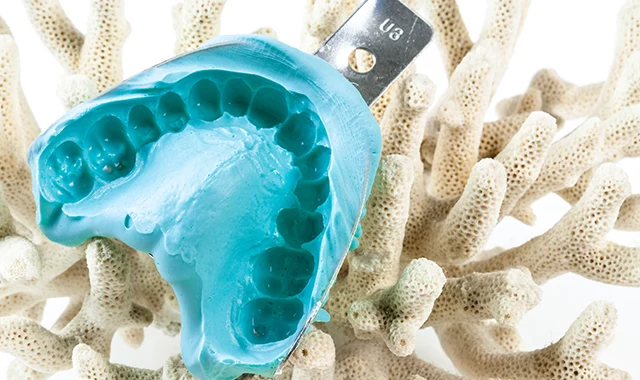- By - Malfaifi
- Posted on
- Posted in Dental Material
Contemporary Impression Materials
A review of contemporary impression materials and techniques
Donovan et al 2004

This article outlines the ideal properties of impression materials and explains the importance of critical manipulative variables. Available impression materials are analyzed relative to these variables, and several ‘‘specialized’’ impression techniques are described.
Ideal properties
1.Elastic recovery:
Elastomeric impression materials must be able to reproduce fine detail of 25 Um. (PVS impression materials are the best). The limiting factor in the system is the ability of gypsum die materials to replicate fine detail. The corresponding specification for gypsum die materials is 50 nm. The putty are required only to record detail of 75 l nm.
2.Dimensional stability:
PVS impression materials have the best elastic recovery at over 99% elastic recovery. Water-based impression materials should be poured up within 10 minutes of removal from the mouth. Condensation silicone impression materials and Polysulfide rubber should be poured no more than 30 minutes after removal. Polyether impression materials bepoured within 1 hour of removal.
3. Flow and flexibility:
PVS materials are reasonably stiff but seem to fall below the threshold where problems with fracture of dies are common. Reversible hydrocolloid is the least rigid of all materials and may be the material of choice when making impressions of multiple periodontally compromised teeth. For dual arch impressions, it is advantageous to use a very rigid impression material. Auto-mix devices for mixing elastomeric impression materials has dramatically improved the workability of these materials.
4. Workability:
When using the dual arch technique for a single-crown preparation, the operator may opt for a quick-setmaterial with a short working time. When making a full-arch impression with several prepared teeth, the clinician may choose a material with a longer working time.
5. Hydrophilicity:
Reversible hydrocolloid and Polyether impression materials are hydrophilics. However, polyether materials require a dry preparation surface to make an acceptable impression. Most of the manufacturers of the newer PVS impression materials claim their materials are hydrophilic. Although this is technically correct, it is misleading because it implies that excellent impressions can be made in a wet environment, which is not true.
6. Long shelf-life:
It is arbitrarily suggested that no more than 6 months’ supply of impression material should be kept on hand at any time.
7. Patient comfort
8. Economics:
Practitioners can reduce costs by using auto-mix devices, by using the dual-arch technique when indicated and custom trays for full-arch impressions, and by reducing the number of remakes.
Principles of impression material manipulation
Several manipulative variables are important to obtain maximum accuracy. These include provision of a uniform bulk of material, insuring that the material adequately adheres to the impression tray, pouring the impression at the appropriate time, using the optimum viscosity materials, and adequate mixing and use of proper disinfection procedures.
Water-based impression materials, such as reversible and irreversible hydrocolloid, provide maximum accuracy with a cross-sectional thickness of 4 to 6 mm. This thickness is achieved with the use of a properly sized stock tray. Elastomeric impressions are most accurate when used with a cross sectional thickness of approximately 2 mm.
PVS impression materials
PVS materials have the best fine detail reproduction and elastic recovery of all. available materials. Because there is no by-product to the setting reaction, they possess remarkable dimensional stability and are odorless and tasteless and pleasant for patients. PVS materials have one disadvantage: PVS materials have a significant interaction with latex. Any contact of unpolymerized PVS material with latex results in inhibition of polymerization of the impression material.
Putty/wash impression techniques
An excellent technique for putty/wash impressions is to use the putty material to fabricate a custom tray.
A second approach is to use a relieved putty impression.
The third approach to putty/wash impressions is the so-called ‘‘simultaneous’’ or ‘‘squash’’ technique. This approach is unacceptable because it is impossible to control the thickness of impression material and excess bulk is used.
Dual-arch impression technique
When one or two posterior teeth are prepared for indirect restorations, it is often advantageous to consider using the dual arch or double-bite impression technique. The dual-arch technique can be used successfully as long as the operator understands the indications and contraindications of the procedure. This technique should be used with a maximum of two prepared teeth. The dual-arch technique should be used only with patients that have existing anterior guidance. Because a half-arch impression is used, no recording of the contralateral arch guidance is made.
The segmental impression technique
Individual custom trays are fabricated on the diagnostic cast for each segment. One millimeter of wax relief is provided, and the trays should extend 3 mm past the gingival margin of the prepared teeth because there are no occlusal stops and because the gingival tissues must prevent over-seating of the trays. These trays may be made using PMM acrylic resin or PVS putty material.
Tooth/implant impressions
A useful method to precisely record the detail of the prepared teeth and the implants is to use a combination of custom impression trays to impress the prepared teeth and then place the implant impression copings and make an over-impression of the arch.
Indirect dowel cores
The indirect technique of obtaining dowel patterns is indicated when multiple dowel cores are required or when radicular attachments are to be used.
Impressions as a communication aid with dental technicians
This impression is made with putty viscosity material. This putty impression is removed, and the provisional restorations are inserted into the indentations in the impression. The putty impression with the embedded provisional restorations is then indexed to the working cast, and the residual ridge area is repoured with a soft tissue cast material.


